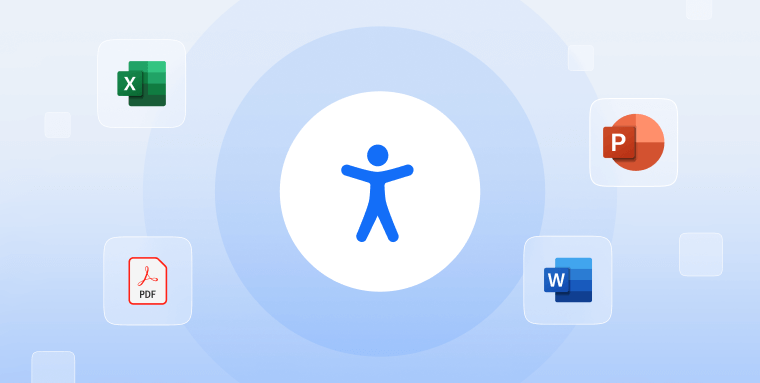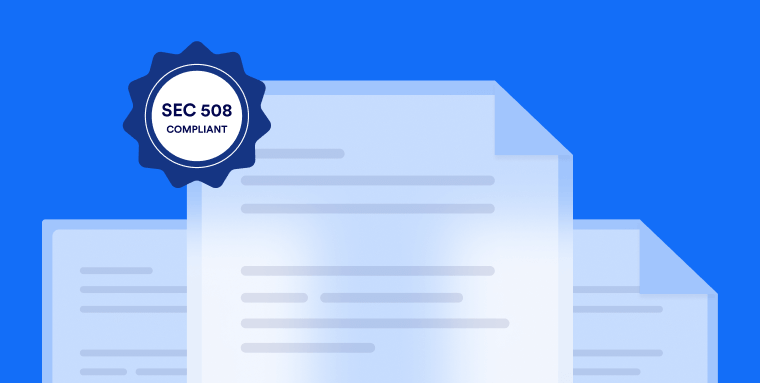Section 508 of the Rehabilitation Act: an overview
A key part of the Rehabilitation Act of 1973, Section 508 was enacted to ensure that members of the disability community have equal access to information and communication technology (ICT) developed, procured, maintained, or used by the federal government.
In its original form, Section 508 did not include instructions pertaining to web accessibility. However, in 2017, an amendment was made to the law that expands its application to a variety of new information and communication technology, including websites and web-based applications, such as online documents.
Today, Section 508 requires all federal agencies, organizations that accept federal funding, and service providers to such organizations to ensure that their online documents and other ICT can be accessed by everyone, including people with disabilities.
WCAG as the standard for Section 508 compliance
Section 508 refers to the Web Content Accessibility Guidelines (WCAG) 2.0 Level AA as its standard for compliance for web-based content. Created by the World Wide Web Consortium (W3C), WCAG is considered by many to be the most influential set of standards impacting global web accessibility policy today, and includes instructions that apply to digital documents.
We will explain what must be done to an online document for it to conform with WCAG 2.0 Level AA later in the blog.
If you’re unsure whether your website conforms to WCAG 2.0 Level AA, you might also want to check out our Section 508 compliance checklist.
Section 508 compliance for online documents: a deep dive

Unlike some laws that apply to web accessibility, Section 508 clearly defines what must be done to online documents (and websites) in order to achieve compliance.
Under Section 508, WCAG 2.0 Level AA is the standard to which online documents (and websites) need to conform.
WCAG 2.0 Level AA includes a number of technical and design-based requirements that apply to a variety of website elements, including, but not limited to, text, video content, and graphics, which must be made to be compatible with assistive technology.
Many of these sections (or success criteria) apply to online documents, such as PDFs, and Microsoft Office files, such as PowerPoint presentations and Excel documents.
It’s important to note that much of your efforts to ensure your online documents are Section 508-compliant will revolve around optimizing and making them compatible with screen reader tools, like NVDA and JAWS.
Screen readers are mainly used by people with vision impairments to access and understand digital content, such as websites and online documents. These tools will scan a PDF or PowerPoint presentation and read its content aloud to users. For screen readers to be able to do this, however, certain elements within your online document must be in place. We will cover them next.
What are the most important elements of a Section 508-compliant online document?
The following elements need to be in place for an online document to conform to WCAG 2.0 Level AA:
Proper tagging
Tagging and labeling are two ways to add descriptive information relating to different elements appearing within online documents.
Proper tagging is both essential for making online documents accessible to people who use assistive technologies, such as screen readers. These tools rely on tags to accurately read and describe the content of online documents to users.
You can manually add tags when using specific platforms. With Adobe Acrobat Pro, for example, you can open the Tags panel, click on the options menu, and select “Add Tags to Document” or “Autotag document.” Adobe Acrobat will automatically generate tags for the document, which you can edit if you feel they aren’t sufficiently accurate.
If your PDF features fillable forms, it is critical you tag them accurately, and include clear instructions on how to complete them.
Text alternatives for meaningful images
Alt text is the text-based description of an image appearing within an online document. Assistive technologies read the alt text aloud to users, allowing them to understand the content of the image. If alt text is missing, or if it improperly or insufficiently describes an image, people who rely on assistive technologies will miss out on critical information
Alt text needs to be added to all meaningful images. Meaningful images are the kind that provide critical, important information. Images that appear purely for decorative reasons must be hidden from assistive technologies.
Proper headings
Headings and subheadings help organize content appearing within an online document and make it easier to navigate a website. Clear headings also help screen reader users quickly scan the content and understand what each section is about, without necessarily reading the entire document. They can then go back and access sections appearing under headings that are relevant to them. Additionally, it’s important to use actual heading tags (e.g., <H1>, <H2>, <H3>) instead of simply increasing the font size.
Proper navigation
An online document should feature clear and consistent navigation. A clickable table of contents allows people to easily skip to sections within an online document they find relevant or interesting.
Sufficient color contrast between text and its background
Using highly-contrasting colors ensures text is sufficiently distinguishable from its background. This allows people with color blindness and other vision impairments to be able to read and comprehend text appearing within the document.
Captions on videos
If an online document has a video embedded within it, it will need to feature captions. These will allow people with vision impairments to understand the information conveyed by the video.
It is important to note that many of these elements (specifically adding tags and labels) allow for people to navigate your PDFs and online documents using their keyboard. Ensuring documents can be navigated exclusively via a keyboard is required under WCAG 2.0 Level AA.
Common accessibility issues found in online documents
Here are some of the most common issues that prevent PDFs, Word files, and other online documents from meeting Section 508 compliance requirements:
- Missing or incorrect tagging: Without proper tags, screen readers can’t interpret the document’s structure or hierarchy
- Missing or incomplete alt text for meaningful images: Images conveying critical information lacking descriptive alt text limit screen reader users' ability to understand content
- Unclear or inconsistent heading structure: Headings that are out of order or styled manually (rather than semantically) confuse navigation for screen reader users
- Insufficient color contrast: Low contrast between text and background makes it difficult for people with certain vision impairments to read content
- Lack of keyboard navigability: Online documents should be navigable via keyboard alone - a core tenet of WCAG
- Embedded media without captions or transcripts: Videos or audio clips without text alternatives like captions or transcripts block access to content for users with hearing impairments
How do you check if your online document is Section 508-compliant?

To check whether your online document is accessible, you can rely on accessibility checker features. Adobe Acrobat and Microsoft Office have built-in accessibility checkers that can identify accessibility issues and suggest ways to remediate them.
Here’s how you can run an accessibility test on a few of the most prominent online document platforms:
Testing PDFs for Section 508 compliance in Adobe Acrobat
Adobe Acrobat scans for common missing accessibility elements. To use Adobe Acrobat's accessibility checker:
- Open the document you want to test for accessibility issues
- Go to Tools and select Accessibility
- Click Full Check/Accessibility Check
- Select options for how you want to view the results under Report Options
- Select the desired Checking Options
- Click Start Checking
Results can be viewed in the Accessibility Checker and Accessibility Report panes.
Testing online documents for Section 508 compliance in Microsoft Office
Using the accessibility checker in Microsoft Office applications (e.g., Word and PowerPoint) is similar to Adobe Acrobat:
- Click Review on the ribbon of the Microsoft 365 app
- Click Check Accessibility
- Review issues in the Accessibility pane
- Apply recommended actions to quickly resolve warnings and errors
It is important to note that these apps can be relied on to identify some accessibility issues. However, they cannot be relied on to identify all issues.
Adjusting accessibility issues within an existing online document so that it conforms to WCAG is called online document remediation. This process is composed of two steps:
- Testing for compliance issues: An online document needs to be thoroughly examined to ensure it incorporates the necessary elements detailed above, such as proper tagging
- Remediating the compliance issues found during the audit: If the test results show that any tags or alt text are absent from the document, they will need to be added to them. Just as importantly, if these elements have been applied incorrectly, they will need to be readjusted so that they align with WCAG requirements
This process can prove challenging, time-consuming, and costly, especially when dealing with complex, lengthy online documents.
This leads many organizations to turn to expert service providers, such as accessServices, to help them audit and remediate their online documents for them.
With an intimate familiarity with the WCAG sections applying to online documents, these experts can be relied on to thoroughly audit online documents, and then remediate them in a more complete fashion. This can prove very beneficial with larger, complex online documents, as expert service providers are better equipped to handle more serious remediation projects.
Click here to see how accessServices can help streamline your online document remediation process.
The importance of ensuring your documents are Section 508-compliant

Enabling equal access to your digital documents is a moral imperative. People with disabilities deserve to be able to access vital information appearing within them, just like everyone else. This is especially true in regards to public organizations (or those seeking to collaborate with such organizations), as they are rightfully expected to treat the disability community fairly.
Additionally, accessible design principles (that apply equally to digital documents), such as clear and concise language, intuitive navigation, and a simple layout, make PDFs and other digital documents easier to use and understand for everyone, including people outside of the disability community.
Finally, it is worth noting that agencies, institutions, and service providers that need to comply with Section 508 but fail to do so actively discriminate against the disability community. Such a violation can result in legal action, including potential lawsuits.
Closing thoughts
Achieving Section 508 compliance requires that you present online documents that can be accessed by everyone, including people with disabilities. To comply with the law, you will need to ensure your PDFs, Microsoft Office documents, and other online documents feature specific elements that will allow people with different disabilities to properly navigate and understand them.
While many platforms offer built-in accessibility testing features, they will not flag all compliance issues existing within a document. Many organizations turn to expert service providers, such as accessServices, to thoroughly audit their online documents for them, and then remediate the compliance issues, if any exist.
Frequently asked questions about Section 508 compliance for documents
Q1. What does Section 508 require for online documents?
A1. Section 508 requires federal agencies—and organizations that receive federal funding or provide electronic and information technology to them—to ensure their digital documents, such as PDFs, Word files, and PowerPoint presentations, are accessible to people with disabilities. The standard used to measure this accessibility is WCAG 2.0 Level AA.
Q2. Which formats are included under Section 508 document accessibility?
A2. Section 508 covers all downloadable or shareable digital documents, including PDFs, Word documents, PowerPoint decks, Excel spreadsheets, and other formats distributed online or by email. These files must be structured and coded so assistive technologies, like screen readers, can interpret and navigate them accurately.
Q3. What are the key accessibility elements required for documents?
A3. Accessible documents must include proper tagging, descriptive alt text for images, consistent heading hierarchy, logical reading order, sufficient color contrast, accessible tables, and support for keyboard navigation. Each element ensures that content is both perceivable and usable for all users.
Q4. What are common accessibility issues found in digital documents?
A4. Common problems include missing or incorrect tags, untagged images, scanned text instead of selectable text, non-descriptive links, poor color contrast, and improperly structured tables. These issues prevent assistive technologies from accurately conveying the document’s content and meaning.
Q5. How should organizations test their documents for Section 508 compliance?
A5. Testing should combine automated accessibility checkers (for tagging, alt text, and color contrast) with manual reviews to confirm logical reading order and compatibility with assistive technology. Built-in tools in Microsoft Office and Adobe Acrobat can assist with initial testing, but expert review remains essential for full compliance.
Q6. Why is document accessibility important beyond legal compliance?
A6. Accessible documents ensure that all users, including those with visual, auditory, or cognitive disabilities, can access the same information equally. Accessibility also improves usability for everyone—enhancing readability, navigation, and mobile responsiveness—while reinforcing inclusivity and protecting an organization’s reputation.
Q7. How can organizations embed document accessibility into their workflows?
A7. Accessibility should be built into every stage of document creation. Use accessible templates, apply heading styles, add alt text, maintain color contrast, and ensure proper reading order before publishing. Regular training, accessibility audits, and review processes help maintain long-term compliance.
Q8. How can accessiBe help with document accessibility under Section 508?
A8. accessiBe’s accessServices provides expert-led auditing and remediation for digital documents to help organizations meet Section 508 requirements. The service includes tagging documents correctly, fixing reading order issues, applying alt text, ensuring color contrast, and verifying usability with assistive technologies. accessServices also delivers detailed reports and documentation to demonstrate compliance, combining professional expertise with best practices aligned to WCAG 2.0 Level AA.





